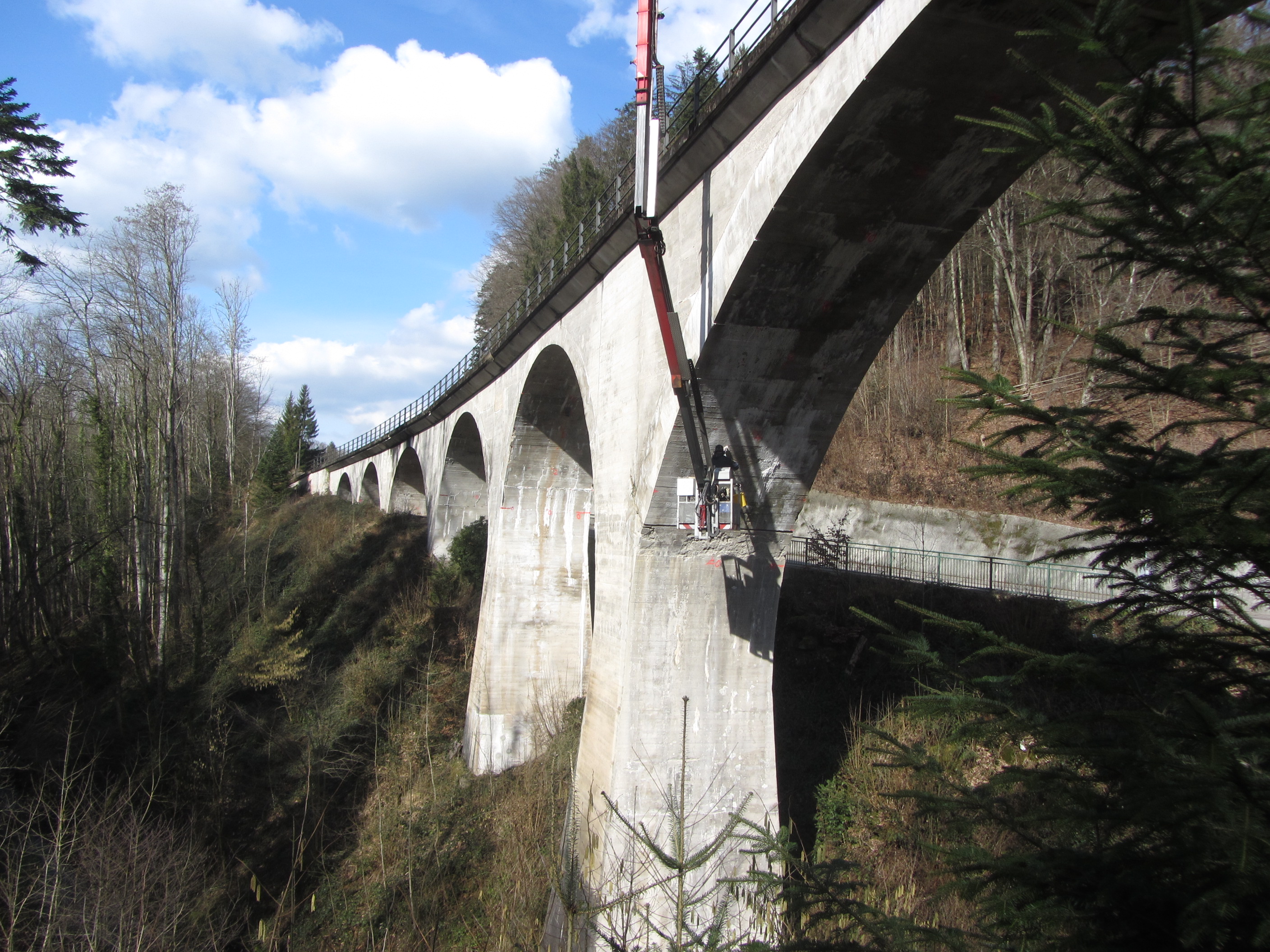
Case Study: The Laufenmühle Viaduct - Rehabilitation under Consideration and Inclusion of Monument Protection
- Project Group:
Development
- Partner:
BWN-Bauingenieure GbR, Förderverein Welzheimer Bahn e.V., FPI Forschungs- und Prüfinstitut Steine und Erden Karlsruhe, IGP Ingenieurbüro Dr.-Ing. Gabriele Patitz, Ingenieurbüro H. Rothenhöfer, IYONYS AG, KIT Innovation HUB
- Startdate:
01.09.2016
- Enddate:
31.12.2018
Project information
- ...is the largest in the ensemble of three viaducts of the Wieslauftalbahn (Laufenmühle viaduct, Strümpfelbach viaduct and Igelsbach viaduct).
- ...is one of the first structures made of "reinforced concrete" in Germany and thus represents an outstanding example of the development of technical infrastructure in Germany.
- ...was built in 1909, the construction time was 5 months.
- ...with a total length of approx. 180 m consists of 8 arches of different construction and span,
- ...has been a listed building since 1992.
- ... was locally repaired before being put back into service as a museum railroad in 2009.
- Structure is subject to the usual structural inspections (simple structural inspection (every 3 years) and main inspection every 6 years).
- Identification of various damages that led to doubts about the stability of the structure. These included:
- locally occurring spalling in the near-surface area
- water-bearing cracks in the structure
- cavities in the cover concrete exposed and corroding iron reinforcements due to a low concrete cover
- Progressive carbonation of the cover concrete
- lime sintering, indicating water transport through the structure
- Defective joints that allow water to enter the structure
- discoloration due to biofilm formation and plant growth
Repair measures were unavoidable in order to preserve the Laufenmühle Viaduct as a monument on the one hand and to maintain the operation of the museum railroad on the other.
Measures
-
Module 1 - Literature research: Research and evaluation of similar structures from the same era and already known repair and prevention measures. Analysis of object-dependent approaches (case studies) in terms of their applicability to the Laufenmühle Viaduct.
-
Module 2 - Inverse static analysis: to determine how to ensure stability, load scenarios of various mechanical stresses were developed depending on the individual components. Inverse static analysis made it possible to identify the parts subject to particular stresses and to calculate the minimum local mechanical material property requirements for these areas.
-
Module 3 - Extended condition analysis: Establishment of a qualified investigation program based on modules 1 and 2, respectively. Step 1: Recording of visually recognizable damage and documentation by means of damage mapping. Step 2: Conduct an extended condition analysis using non-destructive testing methods and targeted core sampling to correlate the determined data.
-
Module 4 - Planning of the repair measures: due to the well-founded data situation, it was possible to deviate from the originally planned massive interventions in the building fabric. Replacement by an alternative concept, which included only minimally invasive interventions. (injection of cracks with special repair mortar).
-
Module 5 - Execution of the repair measure: Execution of test applications before the repair measure in order to check suitability of the injection mortar and settings of the injection equipment. Measurements on the object and taken test specimens checked. Adaptation of the procedure and large-scale implementation.
-
Module 6 - Quality control: during and after the measure are the cornerstone for the performance of the repair. Use of appropriate procedures from the condition analysis.
-
Module 7 - Establishment of a maintenance and prevention concept: regular structural inspections using non-destructive testing methods. Application of a deep hydrophobic coating to protect the structure in case of uncontrolled water ingress.
Results: Advantages/benefits of the innovative approach
-
Comparative observations on the repair of structures of the same era provide information on the performance of alternative repair methods.
Inverse static analysis to identify critical construction details ("hot spots"), whose repair can be planned object- and use-specific. -
Targeted condition analyses provide the necessary information to reduce the execution of the measure to the necessary minimum.
-
Establishment of maintenance targets through stringent quality control
of maintenance and prevention concepts for the long-term preservation of historic buildings -
Reduction of costs from the originally estimated approx. 3.2 million € to less than 2.2 million €.
NOTICE:
Further information on the planning work for the refurbishment can be found in the magazine BAUSUBSTANZ Topic: Concrete refurbishment.
The title describes the planning work for the refurbishment of the Laufenmühle viaduct, a listed building that is over 100 years old, from the survey and evaluation of the existing structure to the structural analysis and detailed design.
